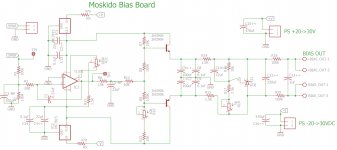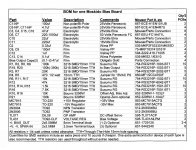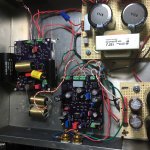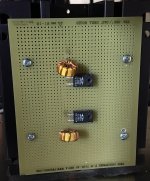Bias Board Ready
Bias board DC offset correction speed is now good. Component value selection is done. See final Bias schematic below. BOM list being reviewed. Even though I used SMD resistors, the Bias board can be constructed from 100% through-the-hole components.
I used 0.47uf Obligato Gold caps as recommended by Bob Prangnell along with 100K resistors coming from the bias Vreg. Great combination of components with a calculated roll-off frequency of about 3Hz.
The position of a few components on the Bias PCB were moved slightly to obtain better spacing between components. PCB design is done and ready for ordering. I can provide a pair of boards made by OshPark for $45/pair plus shipping. I can also email the Eagle files to anyone interested, however I did create at least one of my own PCB devices.
The sq of my Moskido amps is now slightly better than before I redesigned the Bias circuit. The music appears to flow a bit more freely - and this is before the break-in is complete. The main difference between my Bias circuit and the one on the Mad Scientist Audio web site is that the offset adjustment and servo correction of DC-offset is in the power supply regulation before the TL431 Vreg. This puts less circuitry between the Bias Vreg device and the Mosfet inputs.
Bias board DC offset correction speed is now good. Component value selection is done. See final Bias schematic below. BOM list being reviewed. Even though I used SMD resistors, the Bias board can be constructed from 100% through-the-hole components.
I used 0.47uf Obligato Gold caps as recommended by Bob Prangnell along with 100K resistors coming from the bias Vreg. Great combination of components with a calculated roll-off frequency of about 3Hz.
The position of a few components on the Bias PCB were moved slightly to obtain better spacing between components. PCB design is done and ready for ordering. I can provide a pair of boards made by OshPark for $45/pair plus shipping. I can also email the Eagle files to anyone interested, however I did create at least one of my own PCB devices.
The sq of my Moskido amps is now slightly better than before I redesigned the Bias circuit. The music appears to flow a bit more freely - and this is before the break-in is complete. The main difference between my Bias circuit and the one on the Mad Scientist Audio web site is that the offset adjustment and servo correction of DC-offset is in the power supply regulation before the TL431 Vreg. This puts less circuitry between the Bias Vreg device and the Mosfet inputs.
Attachments
Last edited:
Bias PCB BOM and Intructions
Attached are the BOM and instructions for assembling, testing, and adjusting the Bias board in a MOSKIDO amp
Attached are the BOM and instructions for assembling, testing, and adjusting the Bias board in a MOSKIDO amp
Attachments
Last edited:
Hi Carlsor,
what tubes do you use in aikido stage? What is B+ votlage? Do you use AC or DC regulated heaters?
What other amps have you compared your moskido with?
Does moskido handle complex music like classical or metal without smearing of details? - I ask because there is no feedback loop and damping factor is not high either.
Thanks.
what tubes do you use in aikido stage? What is B+ votlage? Do you use AC or DC regulated heaters?
What other amps have you compared your moskido with?
Does moskido handle complex music like classical or metal without smearing of details? - I ask because there is no feedback loop and damping factor is not high either.
Thanks.
Questions Answered
I designed my own Aikido PCB which uses 7193 tubes in the gain stage and 6BX7 tubes in the output stage. This is explained in the http://www.diyaudio.com/forums/anal...6bx7-push-pull-aikido-preamp.html#post4653656 thread and is available for anyone to use. I like the sound of these tubes better than the all 6SN7 Aikido I used previously.
The voltage supply is 310-320VDC. The heaters are AC, elevated to 1/4 voltage, but the heater supply wires are wrapped around a ferrite donut.
My Moskido amps sounded better than my 2A3 parafeed SE amps, Atma-sphere M60, and Marsh A400s which I have owned. I have listened to a lot of high end amps in Hi-Fi shops.
Unbelievable detail, nuance, and ambient musical presentation without being analytical or exaggerated. The lower midrange sounds rich, tight and punchy if needed into the midrange/tweeter speakers on my 98db efficient Emerald Physics CS 2.3 OB speakers. The Marsh handles the woofers below 100Hz. No feedback to a previous stage to muck up the sound. This is as close to live music as I have ever heard. I listen mostly to jazz, classical, and blues. It sounds as good as my source material - the best of which sounds stunningly real.
I designed my own Aikido PCB which uses 7193 tubes in the gain stage and 6BX7 tubes in the output stage. This is explained in the http://www.diyaudio.com/forums/anal...6bx7-push-pull-aikido-preamp.html#post4653656 thread and is available for anyone to use. I like the sound of these tubes better than the all 6SN7 Aikido I used previously.
The voltage supply is 310-320VDC. The heaters are AC, elevated to 1/4 voltage, but the heater supply wires are wrapped around a ferrite donut.
My Moskido amps sounded better than my 2A3 parafeed SE amps, Atma-sphere M60, and Marsh A400s which I have owned. I have listened to a lot of high end amps in Hi-Fi shops.
Unbelievable detail, nuance, and ambient musical presentation without being analytical or exaggerated. The lower midrange sounds rich, tight and punchy if needed into the midrange/tweeter speakers on my 98db efficient Emerald Physics CS 2.3 OB speakers. The Marsh handles the woofers below 100Hz. No feedback to a previous stage to muck up the sound. This is as close to live music as I have ever heard. I listen mostly to jazz, classical, and blues. It sounds as good as my source material - the best of which sounds stunningly real.
Member
Joined 2009
Paid Member
I designed my own Aikido PCB which uses 7193 tubes in the gain stage and 6BX7 tubes in the output stage. This is explained in the http://www.diyaudio.com/forums/anal...6bx7-push-pull-aikido-preamp.html#post4653656 thread and is available for anyone to use. I like the sound of these tubes better than the all 6SN7 Aikido I used previously.
The voltage supply is 310-320VDC. The heaters are AC, elevated to 1/4 voltage, but the heater supply wires are wrapped around a ferrite donut.
My Moskido amps sounded better than my 2A3 parafeed SE amps, Atma-sphere M60, and Marsh A400s which I have owned. I have listened to a lot of high end amps in Hi-Fi shops.
Unbelievable detail, nuance, and ambient musical presentation without being analytical or exaggerated. The lower midrange sounds rich, tight and punchy if needed into the midrange/tweeter speakers on my 98db efficient Emerald Physics CS 2.3 OB speakers. The Marsh handles the woofers below 100Hz. No feedback to a previous stage to muck up the sound. This is as close to live music as I have ever heard. I listen mostly to jazz, classical, and blues. It sounds as good as my source material - the best of which sounds stunningly real.
Hm, interesting. I would guess that Marsh A400s should sound the best as it is the most linear amplifier from you have listened to.
I have built two moskidos some years ago, with 6SL7/6SN7 tubes. It sounded quite good, but lacked detail. It also generated lots of heat.
Than I have found DOGC-H amplifier by Dr. Borivoje Jagodic and that sounds just amazingly good.
SQ and detail
When I changed the Aikido output from a 6SN7 in standard mode to a 6BX7 in push-pull mode there was a huge improvement in detail and dynamics. The 6BX7 tube is much more powerful than the 6SN7 tube and is able to provide tighter control over the MOSFET gates. This is probably even more important in the 50 watt/ch version which has twice as many MOSFET gates to drive. The change in SQ from 6SN7 input tubes to 7193 tubes was more subtle, but real.
Because kacernator had experienced a lack of detail in his MOSKIDO amp I want to point out other factors that could affect musical detail:
1. I use the recommended 0.47uf coupling caps. Smaller values could weaken the control over the MOSFET gates.
2. OSCILLATION can cause less detail and the hardening of the sound. Oscillation can be detected by measuring the DC voltage drop across the MOSFET gate resistor. If there is no oscillation the voltage will read 0.1mv or less. If there is oscillation the reading can be several mv or more. I put 1uH coil inductors in series with both MOSFET source load resistors which may have helped, but do not seem to have negatively impacted the sq - see picture.
3. Better quality parts matter. Putting all Dale RNxx or PRP caps throughout will result in a pleasantly veiled sound. I use TX2575, Caddock, Takman, and Susumu RG resistors. I also use the Obligato Gold resistor in the push-pull circuit feed to the lower half of the 6BX7 tube.
Any idea why the 7193-6BX7 sounds better to you than the all-6SN7 version ???
When I changed the Aikido output from a 6SN7 in standard mode to a 6BX7 in push-pull mode there was a huge improvement in detail and dynamics. The 6BX7 tube is much more powerful than the 6SN7 tube and is able to provide tighter control over the MOSFET gates. This is probably even more important in the 50 watt/ch version which has twice as many MOSFET gates to drive. The change in SQ from 6SN7 input tubes to 7193 tubes was more subtle, but real.
Because kacernator had experienced a lack of detail in his MOSKIDO amp I want to point out other factors that could affect musical detail:
1. I use the recommended 0.47uf coupling caps. Smaller values could weaken the control over the MOSFET gates.
2. OSCILLATION can cause less detail and the hardening of the sound. Oscillation can be detected by measuring the DC voltage drop across the MOSFET gate resistor. If there is no oscillation the voltage will read 0.1mv or less. If there is oscillation the reading can be several mv or more. I put 1uH coil inductors in series with both MOSFET source load resistors which may have helped, but do not seem to have negatively impacted the sq - see picture.
3. Better quality parts matter. Putting all Dale RNxx or PRP caps throughout will result in a pleasantly veiled sound. I use TX2575, Caddock, Takman, and Susumu RG resistors. I also use the Obligato Gold resistor in the push-pull circuit feed to the lower half of the 6BX7 tube.
Attachments
hello i have built 2 moskidos and am now on a third. this third one is a hefty one. i have never used the servo but instead use 2 lm317 and lm338 boards from china. the sound is great and i am not sure its sounds same as i have never heard bobs version bias supply. actually i want to make tubecads diode bias version, the down and dirty 8 diode circuit JB devised. it appears the diodes would have a bad impact on sound as it looks like they would snub the music and lower the input impedance. anyone know what the diode version sound is like? how about the Push pull aikido and the diode version?
Bias Boards pcb files
Carlsor,
I am interested in your bias boards as well. However, it may be simpler for you instead of having to entertain numerous requests from many forum members, to just post the pcb files on the diyaudio forum.
That way forum mebers can organise a group buy or manufacture their own boards from any pcb manufacturer.
Thanks
Carlsor,
I am interested in your bias boards as well. However, it may be simpler for you instead of having to entertain numerous requests from many forum members, to just post the pcb files on the diyaudio forum.
That way forum mebers can organise a group buy or manufacture their own boards from any pcb manufacturer.
Thanks
hello i have built 2 moskidos and am now on a third. this third one is a hefty one. i have never used the servo but instead use 2 lm317 and lm338 boards from china. the sound is great and i am not sure its sounds same as i have never heard bobs version bias supply. actually i want to make tubecads diode bias version, the down and dirty 8 diode circuit JB devised. it appears the diodes would have a bad impact on sound as it looks like they would snub the music and lower the input impedance. anyone know what the diode version sound is like? how about the Push pull aikido and the diode version?
I started with the diode version and the bipolar version sounds way better.
I used the Pass burning amp bias circuit for my moskido...simple elegant solution.
I am using a tubecad 6sn7/6sl7 all in one board...
Dear Carlsor
I would be interested in the files for the bias boards. Will have a go at the Moskido and you have clearly put in efforts to tweak the SQ so why not take advantage of your work. Having PCB files would save a lot of time which is always beneficial.
Am unable to send direct message to you due to forum regulations but if you see this post you might be able to send to me.
I would be interested in the files for the bias boards. Will have a go at the Moskido and you have clearly put in efforts to tweak the SQ so why not take advantage of your work. Having PCB files would save a lot of time which is always beneficial.
Am unable to send direct message to you due to forum regulations but if you see this post you might be able to send to me.
- Home
- Amplifiers
- Tubes / Valves
- Moskido Hybrid Aikido-MOSFET Amplifier



